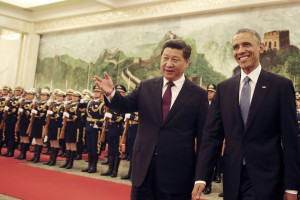
This agreement stipulates the following obligations of both parties: China will stop the growth of carbon dioxide emissions by 2030 or earlier, and increase the share of renewable energy in the energy mix to 20%. The United States, for its part, intends to reduce emissions by 26-28% by 2025 in comparison with 2005 levels (previously, the proclaimed objective was to reduce emissions by 17% from 2005 to 2020).
This agreement appears “historic” because it lays the foundation for overcoming the differences between the two major emitters of greenhouse gases that have long impeded the development of coordinated solutions to combating climate change on the planet. Back in 1997, during the discussion of the Kyoto Protocol, China rejected all US attempts to obligating it to reduce greenhouse gas emissions. At the time, China’s leaders regarded the US position as an attempt to stop the country’s economic growth by means of environmental restrictions, and stated that “at a time when the United States populous is striving for an even more luxurious lifestyle, the Chinese are merely trying to meet their basic needs.” This position taken by the Chinese and shared by most developing countries largely determines the reasoning behind the negotiation process concerning the climate, which is to be completed this next year by the signing of a new agreement.
As one of the major emitters of carbon dioxide in the world (28%), the PRC is subject to intense pressure from the international community which is concerned about the threat posed by the country. China’s carbon dioxide emissions have doubled since the signing of the Kyoto Protocol in 1997. And in 2014 it surpassed Europe in terms of per capita emissions, which greatly weakened its negotiating argument based on its stagnation compared with more developed countries judging by this indicator. The country’s leadership, interested in maintaining its international status, has now been forced to more actively respond to global environmental challenges and to take appropriate measures in overcoming them, while at the same time meeting the interests of economic and political security.
The growth of air pollution caused by burning coal, the main energy source, whose share in the energy mix is 68%, is the cause of social discontent that threatens to undermine the stability of the existing political system. Accordingly, the authorities’ interest in reducing emissions of harmful gases into the atmosphere stems from considerations of its own vitality and preventing the threat of political conflict rising in society. So now the Chinese authorities are taking active steps to limit the growth of environmental pollution, thereby laying the foundation for the fulfilment of commitments to combat climate change.
Undoubtedly, the dividends paid by meeting these obligations are not limited to tightening measures toward combating pollution, but include restructuring the economy, reducing the share of coal in the energy mix, increasing the share of renewable energy sources, and developing modern infrastructure and transport. But these tasks fit into the framework of the already adopted strategy of creating an “ecological civilization”, which involves a transition from a material economy to a knowledge-based and high-tech one. And this, ultimately, means giving new impetus to the economic development and competitiveness of the Chinese economy. Thus, the fight against climate change meets the country’s needs of long-term economic growth and the existing political regime’s need for consolidation.
Also, there is every reason to believe that the country’s leadership will actively pursue its declared course on climate change, which will undoubtedly affect changes in energy policy. The question is how this will affect the Russian economy which is interested in enhancing its presence in China’s energy market. This includes coal. Since 2011, Russian coal companies have been hatching plans to increase the export of energy resources to the neighbouring country, based, until recently, on the growing demand in China, partly to compensate their losses related to the reduction of market share in Western countries from which they have been displaced by American and Colombian producers. But the situation may change dramatically due to the statement issued by Chinese authorities on the reduction of carbon dioxide emissions arising from the burning of coal and increased sharing of renewable energy, which significantly affects the structure of energy consumption in China. Accordingly, the need to import coal from Russia in the near future may be reduced, but on the other hand, the demand for natural gas will increase, the share of which in China’s energy production could double by 2020. Growth of domestic demand for oil is assumed, given the extremely low level of car ownership – about 85 cars per 1,000 people (in the EU this figure is 485). And as the population’s income grows, it will only increase, generating demand for oil.
Now Russia has a temporary reserve for restructuring its energy exports to China based on its long-term development plans, which are also dictated by environmental considerations. There is an alternative to supplying coal to China. The new target market may be Japan, which is gradually increasing its consumption of coal following the changes in the structure of its energy industry after the accident at the Fukushima nuclear power plant. Many of the old nuclear power plants do not meet the strict new safety standards, and their modernization is economically inefficient. In this situation, the supply of coal is a good alternative to expensive imports of natural gas or the use of solar panels.
Of course, in the next ten to fifteen years, Russia’s coal industry will be able to export its products. And, nevertheless, its long-term development strategy must take into account new trends in the energy markets of the world, including the Asia-Pacific Region, which is directly linked to the formulation of objectives in low-carbon development
Natalia Rogozhina, Ph.D. in political sciences, a leading research partner at the Institute of World Economy and International Relations at the Russian Academy of Sciences, exclusively for the online magazine “New Eastern Outlook”.
